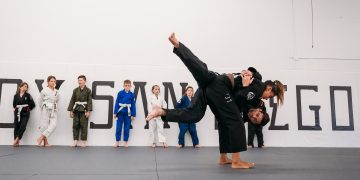
Arts District Liberty Station with its seemingly endless green promenades and public spaces on its 100 park-like acres, is home to more than 100 museums and galleries, artist studios, dance companies, fine dining restaurants, and creative retail spaces.
Recently, Lisa Johnson, president/CEO of the nonprofit NTC Foundation, which manages the historic Arts District, took the Peninsula Beacon on a tour of this cultural mecca at the former Naval Training Center, where 17 of the district’s 26 historic buildings have been completed.
The Arts District is home to nearly 145 tenants including artists, galleries, creative businesses, museums, and nonprofits. More than 800,000 people visit the district annually, adding economic impact and jobs to what was once a shuttered Navy training site.
The first stop on the Arts District tour was the Dick Laub NTC Command Center at 2640 Historic Decatur Road. In 2014, the NTC Command Center was named in honor of Richard “Dick” Laub, a Point Loma Realtor and Navy veteran.
Johnson greeted us inside the command center’s huge front archway. She spoke of the mission of the 23-year-old NTC Foundation. “This is the centennial for the (former NTC) base, which was deactivated in 1997, and it reverted back the original ownership, the City of San Diego,” Johnson said adding redevelopment subsequently went out to bid to developers and McMillin, a local firm, was selected to be the master developer.
“To this day, the McMillin family is still involved,” pointed out Johnson adding, “It was a passion and a legacy project for their family. Part of the plan was for it (Arts District) not to be owned and operated by the City, but to have a private nonprofit foundation activate and operate an arts and culture district.”
Johnson noted there are eight buildings remaining to be developed in the Arts District. “Part of our mission as an arts and culture district is to support nonprofits, so we try to keep our rents reasonable,” she noted, adding hospitality is a top-priority use for the remaining buildings whenever they are developed.

Running the length of the command center’s hallway is usually historic depictions of Point Loma and the tuna-fishing industry. But with the centennial, it is now a gallery of military-themed art utilizing mixed-media 3-D portraits made of colored screws, including a re-creation of the famous Iwo Jima flag raising.
The next tour stop was in the command center at the Nautical History Gallery & Museum, which chronicles U.S. Navy history from 1776-1945. The museum is “captained” by Joseph Frangiosa Jr., a Navy veteran who is like a kid at play in his second home. “People can spend hours with him because he’s so interesting,” noted Johnson, adding the command center also has its own childcare space for employees.
In the rear of the command center is a rose garden, a fountain, and a concrete public space frequently used by roller skaters. This is also where “Installations at the Station” begins. Johnson pointed out installations are “our public art program where we commission regional artists who have art pieces containing QR Codes which can be used in self-guided scavenger hunts.”
One such public art sculpture is a series of brown rusted metal pieces titled Facetime. “Because we’re so device-driven all the time, people don’t spend enough time face-to-face,” said Johnson explaining the sculptures’ theme. “So we created these sculptures and put benches in there so people can do work, or talk to each other.”
The Arts District has been divided into subdistricts including The Quarter, housing a selection of eateries, grocers, and banks, as well as a chapel, various medical practices and office spaces; The Neighborhood, broken into residential townhomes, and single-family dwellings; a 22-acre Educational District consisting of four individual public charter schools collectively known as High Tech Village, and The Rock Church; South Point near the airport offers travelers an array of hotel accommodations; and NTC Park, the 46-acre park by the water.
During the tour, Johnson walked by The Lot Theater, which once hosted famous entertainers like Bob Hope and is adjacent to the Dorothea Laub Dance Place, which is home to five local dance organizations.
Later on, we strolled by some captivating murals painted throughout the Arts District. One is a two-sided mural with a greeting to the former Navy base in front and a postcard addressed to Liberty Station on the back.
Circling back, the tour of Liberty Station Arts District concluded where it began, at the Dick Laub NTC Command Center.
LIBERTY STATION
Established: Oct. 27, 1923.
· Liberty Station was the first permanent Naval Training Center on the West Coast.
· Operating dates: 1923-1997.
· City of San Diego ownership: 1997-2000.
· McMillin master developer: 2000-present.
· Liberty Station’s nonprofit NTC Foundation was founded in 2000.
· Arts District’s first building opened in 2006.
· 2017 marked the 10th anniversary year celebrating the opening of the Arts District (formerly NTC Promenade).
+ Liberty Station’s 1920s architecture was inspired heavily by the Spanish Colonial Revival style that dominated the era.
+ Originally built in 1923 from designs by architect Lincoln Rogers, who was influenced by Bertram G. Goodhue’s designs for the 1915 Panama Exhibition in Balboa Park, with original landscaping designed by the park’s superintendent of the time.
+ 52 buildings designated as a Historic District on the National Register of Historic Places.
· Liberty Station total acreage: 361.
· Arts District total acreage: 100.
· Total parkland acres: 48.
· Shopping and retail options: 24.
· Restaurant and dining options: 30.













Discussion about this post